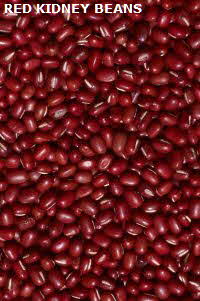RED KIDNEY BEANS POISONINGSee also: Kidney Beans Trivia ; Article on Beans
Red Kidney Bean Poisoning is an illness caused by a toxic agent, Phytohaemagglutnin (Kidney Bean Lectin)This toxic agent is found in many species of beans, but it is in highest concentration in red kidney beans (Phaseolus vulgaris). The unit of toxin measure is the hemagglutinating unit (hau). Raw kidney beans contain from 20,000 to 70,000 hau, while fully cooked beans contain from 200 to 400 hau. White kidney beans, another variety of Phaseolus vulgaris, contain about one-third the amount of toxin as the red variety; broad beans (Vicia faba) contain 5 to 10% the amount that red kidney beans contain. 
As few as 4 or 5 beans can bring on symptoms. Onset of symptoms varies from between 1 to 3 hours. Onset is usually marked by extreme nausea, followed by vomiting, which may be very severe. Diarrhea develops somewhat later (from one to a few hours), and some persons report abdominal pain. Some persons have been hospitalized, but recovery is usually rapid (3 - 4 h after onset of symptoms) and spontaneous. The syndrome is usually caused by the ingestion of raw, soaked kidney beans, either alone or in salads or casseroles. As few as four or five raw beans can trigger symptoms. Several outbreaks have been associated with "slow cookers" or crock pots, or in casseroles which had not reached a high enough internal temperature to destroy the glycoprotein lectin. It has been shown that heating to 80 degrees C. may potentiate the toxicity five-fold, so that these beans are more toxic than if eaten raw. In studies of casseroles cooked in slow cookers, internal temperatures often did not exceed 75 degrees C. All persons, regardless of age or gender, appear to be equally susceptible; the severity is related only to the dose ingested.
No major outbreaks have occurred in the U.S.Outbreaks in the U.K. are far more common, and may be attributed to greater use of dried kidney beans in the U.K., or better physician awareness and reporting. NOTE:
The following procedure has been recommended by the PHLS (Public Health Laboratory Services, Colindale, U.K.) to render kidney, and other, beans safe for consumption: * Soak in water for at least 5 hours.
* Pour away the water.
* Boil briskly in fresh water for at least 10 minutes.
* Undercooked beans may be more toxic than raw beans.
Sources: FDA (U.S. Food and Drug Administration) Center for Food Safety & Applied Nutrition.
BAD BUG BOOK (Foodborne Pathogenic Microorganisms and Natural Toxins Handbook). | 